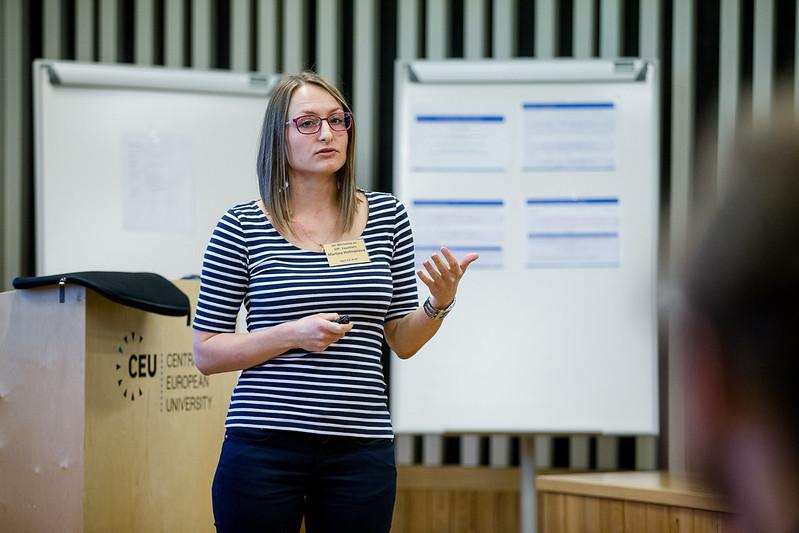While lecturing is perhaps the most overused and abused genre of academic teaching, online lectures can be highly effective. This page provides suggestions for two lecture formats that are widely used in online and hybrid courses: pre-recorded lectures and interactive lecturing.
Pre-Recorded Lectures
Pre-recorded lectures can help students prepare for synchronous class sessions (Kennedy et al, 2021). Additionally, they can also make lectures more accessible, as they give students the choice of when to watch and can be paused, re-watched, and downloaded. Here are some tips if you opt to record your lectures:
- Make videos short and lively. We recommend 20 minutes maximum, recorded in 6-8 minute segments. These can be structured through guiding questions or stages of the inquiry process (problem, exploration, application, resolution).
- If you choose to make a longer video, consider creating a guide for students to work on while watching the lecture.
- Record a video each week that provides a general overview to the week’s topic, summarizes key themes, and/ or revises a topic that students find particularly difficult.
- Consider embedding interactive questions into the lecture where students need to post a response before they can continue watching.
Using Panopto [CEU login required], you can easily record presentations, add interactive questions, and post them on Moodle.
Interactive Lecturing
Interactive lecturing promotes two-way teacher-and-student communication during a live class session (Murphy & Sharma, 2010). With this approach, instructors build in opportunities for students to engage actively with course content, the instructor, and peers during a lecture. Although it may be more challenging to engage students during online and hybrid lectures, many CEU-supported tools allow both remote and on-campus students to participate via computer, laptop, or mobile device.
In the table below, we have suggested a few tools and paired them with techniques from Interactive Lecturing (Barkley & Howell Major, 2018, full text available via CEU Library) to demonstrate a range of possibilities. For external tools, we recommend reviewing the tool's GDPR compliance and discussing privacy and data collection with students.
| Feature | Tools | Interactive Lecturing Technique (Barkley and Howell Major, 2018) |
| Chat |
Zoom chat or Microsoft Teams |
Translate That!: The instructor asks students to “translate” the recently provided information into plain language for an imagined audience in the chat. One Sentence Summary: The instructor asks students to summarize the most important ideas from a lecture in a single sentence in the chat. |
| Polls | Zoom polls |
Snap Shots: The professor pauses, displays a multiple-choice question, and individual students choose which answer they think is correct. Then pairs try to convince their partner that their answers are correct. Preview Guide: In a poll, students state their beliefs about whether statements related to the lecture are true or false. At the end of the lecture, they reevaluate the statements. |
| Surveys | Microsoft Forms |
Individual Readiness Assurance Tests: Quizzes that students complete after an out-of-class reading, video, or other homework assignment. Post-Lecture Knowledge Survey: The professor shares a survey with questions or problems related to the knowledge and skills just shared. |
| Digital Whiteboard |
Zoom or Microsoft Whiteboard |
3-2-1: Students post three things they learned, two things they found particularly interesting, and one question they still have about the lecture. |
| Shared Documents |
Microsoft Word Online |
Note-taking Pairs: The instructor provides class time for student pairs to work together to improve their individual notes. |
Like all teaching and learning strategies, lecturing can also create barriers for some students. Here are some suggestions to create a more inclusive environment during online and hybrid lectures:
- Vary the length and interactivity of lectures depending on what best meets the learning goals.
- Share discussion points in Moodle before class to avoid putting students on the spot.
- When appropriate, give remote students time to answer first before opening the discussion to on-campus students.
- Provide opportunities for silent thinking and for anonymous participation and engagement (Vathy and Hogan, 2019).
Resources
IT SharePoint site: Technical guides for using CEU-supported tools for online and hybrid class sessions [CEU login required]
View the Elkana Center's pages on Live Class Sessions, Discussions, and Assessment for more about online and hybrid teaching at CEU.
